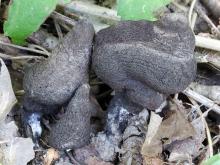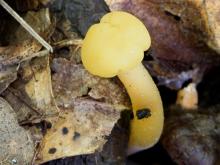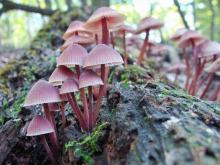Mushrooms
Media

Species Types
Scientific Name
Tremellodendron pallidum
Description
The jellied false coral is a branching, whitish, leathery, coral-like jelly fungus. It grows on the ground in deciduous or mixed woods.
Media

Species Types
Scientific Name
Xylaria polymorpha
Description
Dead man’s fingers is a black, distorted, clublike or finger-shaped fungus with a wrinkled, charcoal-like surface. It grows in clusters at the base of rotting deciduous trees and stumps.
Media

Species Types
Scientific Name
Leotia lubrica
Description
The jelly baby is a small mushroom with a gelatinous, orangish yellow stalk and head. It grows in groups on soil in mixed woods.
Media

Species Types
Scientific Name
Polyporus badius
Description
The black-footed polypore has a smooth, wavy brown cap with whitish or tannish pores on the underside and a black, smooth, off-center stalk. It grows singly or in groups of up to several on dead wood and stumps of deciduous trees.
Media

Species Types
Scientific Name
Polyporus radicatus
Description
The rooting polypore has a scruffy, tough, yellowish-brown cap with whitish-yellow pores, and a stalk with a long, black, rootlike filament. It usually grows singly, on the ground near stumps or attached to buried roots.
Media

Species Types
Scientific Name
Tylopilus felleus
Description
The bitter bolete has a large, tannish brown cap with pinkish white pores and a webbed, tannish brown stalk. It grows singly or scattered on the ground in mixed woods.
Media

Species Types
Scientific Name
Amanita thiersii
Description
Thiers amanita has a white, gilled cap, and the stem is large, white, sticky, and shaggy. It grows in lawns, pastures, and prairies, often in fairy rings.
Media

Species Types
Scientific Name
Amanita spp. (about 600 species, worldwide)
Description
This large group of mushrooms accounts for 90 percent of mushroom-related deaths, so every mushroom hunter should be familiar with amanitas. They contain one of the deadliest poisons found in nature!
Media

Species Types
Scientific Name
Mycena haematopus
Description
The bleeding mycena is a small mushroom with a bell-shaped, reddish brown cap that bleeds dark red when cut. It usually grows in clusters on decaying wood.
Media

Species Types
Scientific Name
Amanita rubescens
Description
The blusher has a tan to reddish brown cap with pinkish brown patches and a ring on the stalk; the entire mushroom bruises reddish. It grows on the ground in oak woods and under white pines.
See Also



Media

Species Types
Scientific Name
Monotropa hypopitys
Description
Pinesap is a plant that puts the "wild" in wildflower! It lacks chlorophyll, so its roots connect to fungi underground and absorb nutrients from the fungi.
Media

Species Types
Scientific Name
Cladophora, Pithophora, and Spirogyra spp., and others
Description
Filamentous green algae forms green, cottony masses that are free-floating or attached to rocks, debris, or other plants.
Media

Species Types
Scientific Name
Monotropa uniflora
Description
Indian pipe lacks chlorophyll, so it is white, not green. Below ground, its roots join with fungi that connect to tree roots. This plant, then, takes nourishment indirectly from the trees.
About Mushrooms in Missouri
Mushrooms are a lot like plants, but they lack chlorophyll and have to take nutrients from other materials. Mushrooms are neither plants nor animals. They are in a different kingdom — the fungi. Fungi include the familiar mushroom-forming species, plus the yeasts, molds, smuts, and rusts.
Always be cautious when eating edible mushrooms. Be absolutely sure of the ID, and only eat a small amount the first time you try it to avoid a reaction..





















